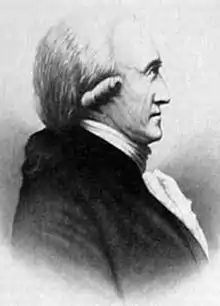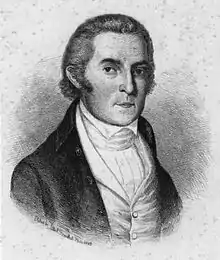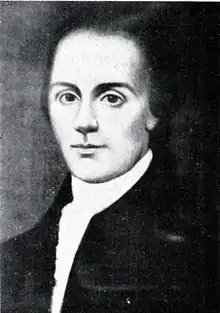| 2nd North Carolina General Assembly (1778-1779) | |||||||
|---|---|---|---|---|---|---|---|
| |||||||
| Overview | |||||||
| Legislative body | North Carolina General Assembly | ||||||
| Jurisdiction | North Carolina, United States | ||||||
| Meeting place | 1st New Bern, 2nd Hillsborough, 3rd Halifax sessions | ||||||
| Term | 1778–1779 | ||||||
| North Carolina Senate | |||||||
| Members | 41 Senators (41 counties, including Washington County/District) | ||||||
| Speaker | Whitmell Hill | ||||||
| Clerk | John Sitgreaves | ||||||
| North Carolina House of Commons | |||||||
| Members | 88 Representatives (41 counties with two each, 6 districts with one each) | ||||||
| Speaker | John Williams, Thomas Benbury | ||||||
| Clerk | John Hunt | ||||||
| Sessions | |||||||
| |||||||
The North Carolina General Assembly of 1778 met in three sessions in three locations in the years 1778 and 1779. The first session was held in New Bern from April 14 to May 2, 1778; the second session in Hillsborough, from August 8 to August 19, 1778; the third and final session in Halifax, from January 19 to February 13, 1779.[1][2][3][4]
Each of the 39 North Carolina counties and Washington District/County were authorized by the North Carolina Constitution of 1776 to elect one Senator to the Senate and two representatives to the House of Commons. In addition, six districts (also called boroughs) were authorized to elect one House representative each. Richard Caswell was elected governor by the legislature.[1][2][5]
Legislation
This general assembly established Wilkes County in 1778[6] This general assembly established the following counties in their last session in 1779: Franklin,[7] Gates,[8] Jones,[9] Lincoln,[10] Montgomery,[11] Randolph,[12] Richmond, Rutherford,[10] Warren,[7] and Wayne Counties. For additional laws and minutes of the 1778 General Assembly, see Legislative Documents.[13]
Councilors of State
The General Assembly elected the following Councilors of State on April 18, 1778:[2]
- Joseph Leech, from Craven County
- Thomas Bonner from Beaufort County
- William Cray from Onslow County[note 1]
- Edward Starkey from Onslow County
- Robert Bignall from Edgecombe County
- Richard Henderson from Granville County[note 2]
- William Haywood from Edgecombe County[note 3]
- William Bryan from Craven County
- John Simpson from Pitt County
- Frederick Jones from New Hanover County (elected on February 3, 1779)
House of Commons
House leadership
- Speaker: John Williams (Granville County), until April 28, 1778; Thomas Benbury (Chowan County) elected to replace Williams.
- Clerk: John Hunt (Franklin County)
- Assistant Clerk: Joseph Blithe
House members




The members of the House and the counties and districts they represented are listed below.[3]
Senate
Senate leadership
- President pro tempore: Whitmell Hill, until his election to the Continental Congress; Allen Jones elected to replace Hill
- Clerk: John Sitgreaves
Senate members


The following senators and the counties they represented are listed.[4]
Notes:
- ↑ William Cray Died in office.
- ↑ Richard Henderson declined to serve.
- ↑ William Haywood declined to serve.
- ↑ Alderson Allerson was elected county entry taker. His seat was declared vacant on 19 January 1779.
- ↑ Thomas Respress was elected to replace Alderson Allerson. He took office on February 2, 1779.
- ↑ Thomas Amis was elected to another office. His seat was declared vacant on May 2, 1778.
- ↑ Benjamin Clark was elected to replace Thomas Amis. He took office on August 8, 1778.
- 1 2 Lewis Dupree took office on August 8, 1778 after a special election.
- ↑ Ephraim McLaine was elected, but there is no evidence of service.
- ↑ Charles McLean took office on August 13, 1778.
- ↑ Caleb Grady's seat vacated because he held another public office.
- ↑ Willis Bright was elected to replace Caleb Grandy. He took office on January 21, 1779.
- ↑ John Gray's seat was vacated because he held another public office.
- ↑ William Burgess was elected to replace John Gray. There is no evidence of service.
- ↑ John Tillman resigned on April 30, 1778.
- ↑ Abner Nash was elected to replace John Tillman. He took office on August 14, 1778.
- ↑ Holowell Williams was elected, but there is no evidence that he took office.
- ↑ Jonas Johnston was named county entry taker. His seat was declared vacant on April 27, 1778. A new election was held. Johnston was re-elected and he took office on August 8, 1778
- ↑ John Williams resigned on April 28, 1778 when elected to Continental Congress.
- ↑ Thomas Person was elected to replace John Williams. He took office on August 8, 1778.
- ↑ John Butler was named county record taker. His seat was declared vacant on April 27, 1778.
- ↑ Thomas Burke was elected to replace John Butler. He took office on August 8 and resigned on August 18 when elected to the Continental Congress.
- ↑ Mark Patterson was elected to replace Thomas Burke. He took office on January 20, 1779.
- ↑ There is some question about sources that say it died earlier than this date.
- ↑ William Robeson was named county entry taker. His seat was declared vacant on April 27, 1778.
- ↑ John Simposon was elected to replace William Robeson. He took office on August 8 and was then elected to Council of State, so he resigned on August 18.
- ↑ James Gorham was elected to replace John Simpson. He took office on January 21, 1779.
- ↑ William Gilbert was expelled from office on February 8, 1779 for fraud.
- ↑ Isham Webb died in April 1778.
- ↑ Benjamin Spruill was elected to replace Isham Webb. He took office on August 8, 1778.
- ↑ William Cooke was named county clerk of court and his seat was declared vacant on April 27, 1778.
- ↑ Jesse Walton was elected to replace William Cooke. He took office on January 19, 1779.
- ↑ Charles McDowell held another public office, so his seat was declared vacant on April 22, 1778.
- ↑ Ambrose Ramsey held another public office, so his seat was declared vacant on April 22, 1778.
- ↑ John Birdsong was elected to replace Ambrose Ramsey. He took office on August 8, 1778.
- ↑ Ralph Gorrell held the office of county entry taker, so his seat was declared vacant on April 22, 1778.
- ↑ Alexander Martin was elected to replace Ralph Gorrell. He took office on August 12, 1778.
- ↑ Needham Bryan held another public office, so his seat was declared vacant on April 22, 1778.
- ↑ Whitmell Hill was appointed to the Continental Congress, so he resigned on August 12, 1778.
- ↑ Kenneth McKenzie was elected to replace Whitmell Hill. He took office on January 19, 1779.
- ↑ John Eason held the office of county entry taker, so his seat was declared vacant on April 15, 1778.
- ↑ Thomas Harvey was elected to replace John Eason. He took office on January 20, 1779.
References
- 1 2 Connor, R.D.D. (1913). A Manual of North Carolina (PDF). Raleigh: North Carolina Historical Commission. Retrieved April 27, 2019.
- 1 2 3 Wheeler, John H. (1874). The Legislative Manual and Political Register of the State of North Carolina. Retrieved April 9, 2019.
- 1 2 Lewis, J.D. "North Carolina State House 1778". The American Revolution in North Carolina. Retrieved April 17, 2019.
- 1 2 Lewis, J.D. "North Carolina State Senators 1778". The American Revolution in North Carolina. Retrieved April 17, 2019.
- ↑ Holloman, Charles R. 1979.Caswell, Richard. NCpedia.
- ↑ North Carolina Laws, General Assembly of 1778-1779, Chapter 22, page 178
- 1 2 North Carolina Laws, General Assembly of 1778-1779, Chapter 19, pages 227–230
- ↑ North Carolina Law, General Assembly of 1778-1779, Chapter 20, pages 230-232
- ↑ North Carolina Law, General Assembly of 1778-1779, Chapter 18, pages 225-227
- 1 2 General Assembly of 1778-1779 (1779). North Carolina Law, General Assembly of 1778-1779, Chapter 23, An Act for dividing Tryon County into two district counties by the name of Lincoln and Rutherford (PDF). pp. 236–237. Retrieved November 11, 2019.
{{cite book}}: CS1 maint: numeric names: authors list (link) - ↑ North Carolina Laws, General Assembly of 1778-1779, Chapter 21, pages 232-234
- ↑ General Assembly of 1778-1779 (1779). North Carolina Law, General Assembly of 1778-1779, Chapter 22, An Act for dividing Guilford County into two district counties by the name of Randolph and Guilford (PDF). pp. 234–236. Retrieved November 11, 2019.
{{cite book}}: CS1 maint: numeric names: authors list (link) - ↑ Lewis, J.D. "Laws of North Carolina, 1784" (PDF). Carolana. Retrieved November 10, 2019.
- ↑ Johnston, Hugh Buckner (1988). "Jonas Johnston". Retrieved November 4, 2019.
- ↑ Powell, William S. (1991). "Thomas Owen". Retrieved November 4, 2019.